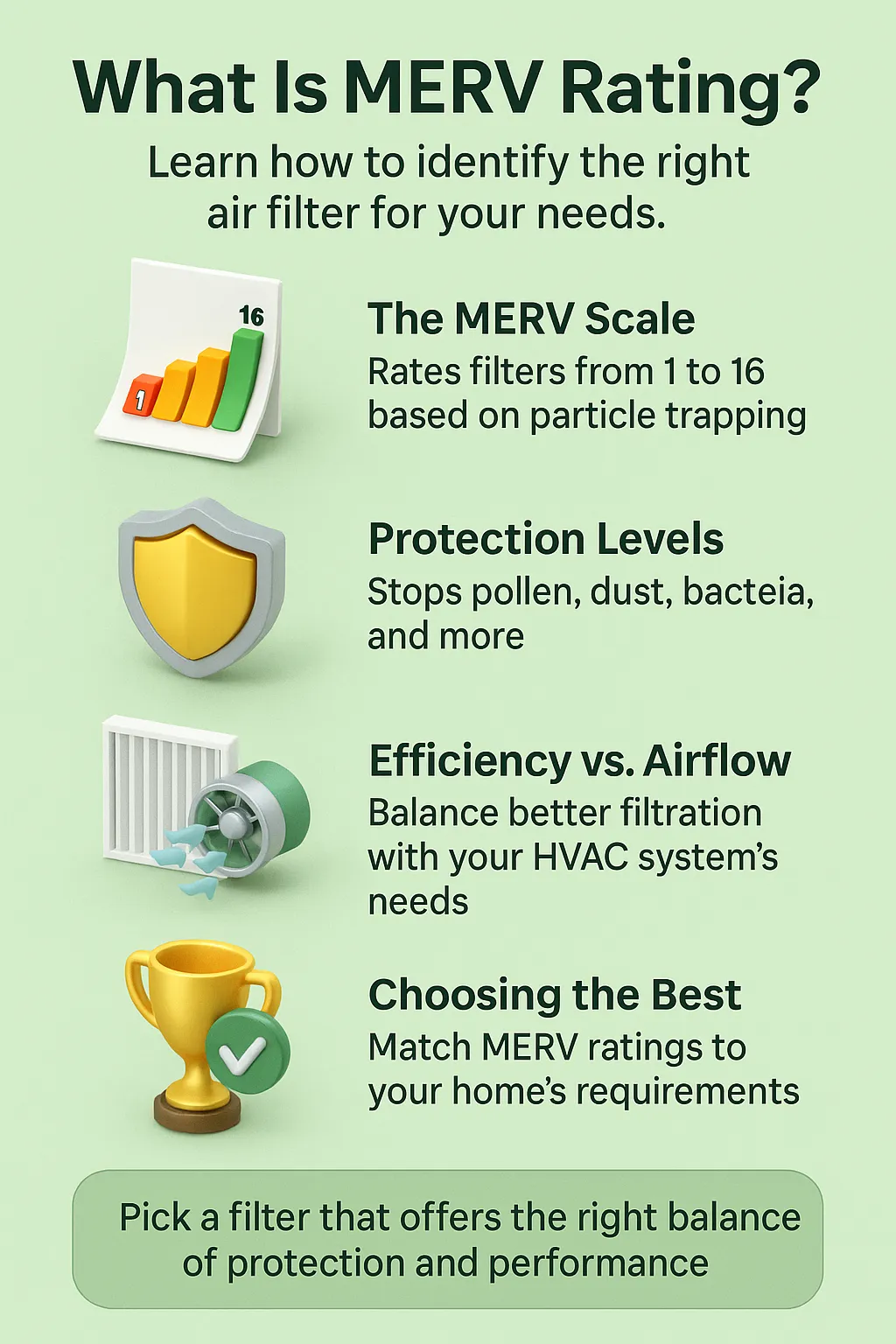So what is MERV rating? It’s a scale that shows how well a filter captures everything from visible dust to microscopic particles like smoke, bacteria, and even some viruses. But here’s what I’ve learned firsthand: choosing the highest number isn’t always the smartest move. I’ve seen older HVAC systems struggle under the weight of filters they weren’t designed for, and I’ve seen families transform their air quality just by stepping up one or two levels.
In this guide, I’ll explain not only what the MERV scale means but also share insights from real-world cases—families with allergies, schools aiming for safer classrooms, and apartments with aging HVAC units. By the end, you’ll know how to choose a filter that not only protects your health but also keeps your system running strong.
Top Takeaways
MERV = efficiency. Higher rating = smaller particles trapped.
MERV 8–13 works best. Good balance for most homes.
MERV 13+ adds protection. Captures smoke, bacteria, some viruses.
Small upgrades help. 1–2 levels up can ease allergies and reduce dust.
Replace often. Every 1–3 months for clean air and system health.
Understanding MERV Ratings and Choosing the Right Protection
The MERV rating—short for Minimum Efficiency Reporting Value—is the standard scale developed by ASHRAE (American Society of Heating, Refrigerating, and Air-Conditioning Engineers). It measures how effectively an air filter captures particles, from larger dust and lint to microscopic pollutants. The scale runs from MERV 1 to MERV 20.
MERV 1–4: Basic protection. Stops large dust but does little for air quality.
MERV 5–8: Common for homes. Captures dust, pollen, and mold spores—enough for most families without straining systems.
MERV 9–12: Stronger protection. Filters pet dander, fine dust, and some smoke particles. A good choice for homes with pets or allergies.
MERV 13–16: High-level defense. Traps bacteria, smoke, and even some viruses. Used in hospitals and schools, but suitable for homes if HVAC systems allow.
MERV 17–20: Ultra-fine filtration. Designed for cleanrooms and surgical environments, not standard residential use.
Here’s the key insight: the right filter isn’t always the highest-rated one. A MERV 16 may seem protective, but if your HVAC isn’t designed for it, airflow can be restricted, energy costs can spike, and the system itself can suffer damage. For most households, MERV 8–13 filters strike the perfect balance—delivering healthier air and true protection while keeping your system efficient.
By understanding the scale and matching it to your needs, you can select a filter that does more than block dust—it truly protects your health, your family, and your HVAC system.
“I’ve seen homeowners spend money on the highest MERV filters, only to find their systems straining and energy bills climbing. In contrast, families who chose the right balance—usually a MERV 8 to 13—noticed cleaner air, fewer allergy symptoms, and a system that kept running smoothly. The best filter isn’t the most powerful—it’s the one that truly protects both your air and your HVAC.”
Case Study & Real-World Examples
Asthma Relief – Family Home
Used a MERV 6 filter → child had nightly asthma attacks.
Switched to MERV 12.
Results: fewer symptoms, better sleep, less dust.
Cleaner Classrooms – School District
Concern: safer air during 2020 reopening.
Upgraded to MERV 13.
Teachers noticed fresher air, students had fewer allergy issues.
Absentee rates dipped; ducts stayed cleaner.
Older Apartment Complex – Balance Needed
Manager wanted MERV 16 → system too old to handle it.
Installed MERV 10 instead.
Results: less dust, fewer odor complaints, system ran smoothly.
Key Takeaways
Small upgrades = big results (health, comfort, dust reduction).
Schools benefit from higher MERV when systems allow.
Balance matters → right rating = protection + efficiency.
Final Thought & Opinion
MERV ratings are more than numbers. They define whether you’re breathing dusty, stale air or enjoying cleaner, healthier air each day.
What I’ve Seen
Families with allergies found relief by upgrading just 1–2 levels.
Schools improved classroom safety with MERV 13.
Older HVAC systems ran better when we chose balance instead of extremes.
What I’ve Learned
The best filter isn’t always the highest-rated one.
The “right” MERV is the one that matches your health needs and your system’s capacity.
My Advice
Don’t treat filters as afterthoughts.
See them as investments in health and comfort.
Replace them regularly to keep protection strong.
Bottom line: The right MERV filter doesn’t just protect your HVAC—it protects you.
Next Steps: Put Cleaner Air Into Action
Check your HVAC manual → know the highest MERV your system supports.
Match your needs
MERV 6–8 → basic dust
MERV 9–12 → pets, allergies, mild asthma
MERV 13+ → fine particles, viruses (if system allows)
Inspect your filter → check rating, condition, last change.
Upgrade smartly → step up 1–2 levels without restricting airflow.
Replace regularly → every 1–3 months based on use and air quality.
Track results → look for less dust, easier breathing, fresher air



